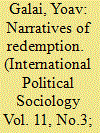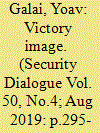| Srl | Item |
| 1 |
ID:
155146


|
|
|
|
|
| Summary/Abstract |
A political project will be considered legitimate if the narrative that frames it is. This article explores the legitimizing function of narratives as well as the ways in which the narrative form can travel across borders, contexts, and discourses. The new, afforested landscape of Israel is the result of an intensive campaign of planting almost a quarter of a billion trees. Forests often cover the remains of Palestinian villages, demolished after they were abandoned in 1948. Nevertheless, through the work of narrative, the afforested landscape is instilled with a sense of the recovery of an imagined biblical landscape associated with ancient Jewish ownership of the land. This basic narrative of “redemption” has been carried over to frame new forests that similarly overwrite land claims by indigenous inhabitants. However, the new forests are presented as celebrations of international cooperation by involving foreign actors. Nevertheless, as I shall demonstrate, the particular designations of these forests, which are international in nature, still comply with a basic narrative of “redemption.”
|
|
|
|
|
|
|
|
|
|
|
|
|
|
|
|
| 2 |
ID:
167407


|
|
|
|
|
| Summary/Abstract |
This article interrogates the concept of the ‘victory image’ in Israel as a militarized visual economy. What began as a visual illustration of warfighting became an integral part of operational considerations. My own contribution as an embedded photographer to that economy is used as a prism for larger changes in visual politics. These changes relate to the proliferation of an actuarial gaze as the overarching ordering principle of imaging in the subsequent Gaza Wars. Instead of celebratory images of military achievements, Israeli officials opted for information visualizations to convey a sense of achievement, allowing for the continuation of the ‘visual economy,’ but with Palestinian victims of indiscriminate attacks ignored.
|
|
|
|
|
|
|
|
|
|
|
|
|
|
|
|